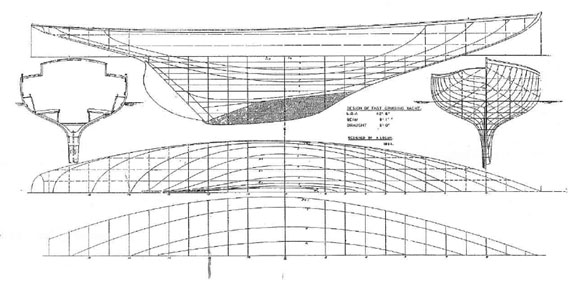|
|
|
|
|
THE SECOND LITTLE JIM (1934-) The insurance money amounted to £230, less than a third of the cost of replacement. However Mitchelson’s Aunt Bertha Wilson, was keen to see her nephew continue sailing and again assisted to finance a replacement. There was briefly a proposal to seek designs from both Charles Bailey Junior and Arch Logan with a view to selecting the best, although this came to nothing. The Wilson family’s long and close association with the Logans and Arch in particular, ensured Arch Logan was briefed to design and oversee the building of the second Little Jim. The Logans had built Queenie, Moana, and later Tawera in addition to several earlier yachts for the Wilson family. Logan had retired from full-time boatbuilding in 1910 with the sale of the Logan Brothers yard, but continued to design and build to order smaller craft, notably M class18 foot centre-boarders. The commission to design the second Little Jim was his first significant keel yacht design since 1910 some 24 years before. Logan was asked to design a fast cruiser. His design has been often compared with Rainbow built 35 years before in 1898. Given Rainbow w as probably the most successful keel yacht design it is not unlikely Logan began with Rainbow’s design and modified it. She differed with more beam and higher topsides for her day, although still very low by modern standards. Not much time w as lost as by April 1934 the design was completed, and Logan was constructing the moulds. On Logan’s recommendation, Arnold (Bill) Couldrey was contracted to build her. Couldrey obtained the use of a building at Sulphur Point, Northcote (now cut off from the sea by the northern approach to the Auckland Harbour Bridge). The agreed cost was £900.00 complete; including rig and sails (a clinker tender was extra at a standard price of £1.00 a foot). Logan closely supervised her building. Couldrey later commented on Logan "He was a clever old bloke. I learnt more f rom him in twelve months than I had learnt before in my life." Logan, according to Jerry Lane who was employed by Couldrey at the time, also built the keel, keelson, stern piece, stern post and the bib (the solid piece at the end of the counter stern). These were all carted f rom Logan’s workshop at his home on Stanley Point to Couldrey's yard and set up under his direction. |
 |
|
Logan visited at least weekly and was picked up by car
and driven over to the yard where he then inspected progress and gave his approval or ordered work to be redone according to his strict view on how things were to be done. The lead was, in the Logan fashion, poured into a purpose built mould with the keel and keel bolts in place. This caused charring of the keel, a typical Logan trademark. The hull was then constructed on top of the keel. Logan, according to Lane, did not make his plans available to all those in the yard and was very protective of them at the time. The only drawing Lane recalls seeing was a sketch of the internal layout for guidance. During construction Bertha Wilson often visited the yard and took many photographs as well as home movies of construction in progress, which have been found and preserved. The lead w as covered in copper to protect it, although w ith the advent of modern antifouling paints she has not carried copper over her keel for many years. By August she w as being planked. Built with three kauri skins, two opposing diagonal and the last fore and aft, with 8 stringers she had enormous strength. Some of the deck fittings and forward cabin top portholes from the first Little Jim were installed. Completed she measured 42 feet 10 inches in length, 28 feet on the w aterline, 9 feet beam, and 6 feet in draft. . She was difficult to launch from Couldrey's yard and the cradle was moved down to the tide by timber jacks. Late on 19th of November 1934 she was launched on the high tide and placed in "Victory's" mooring at Westhaven while Victory was hauled out at the time for annual maintenance. On her launch Logan supervised the placement of her sheet leads and the rest of the rigging by string, sight and much experience. A film recording of her construction and launch has been found and preserved. On her first weekend out she went to Matiatia, Waiheke Island, where she was visited by RNZYS flag officers and many other interested yachtsmen. |
 |
|
|